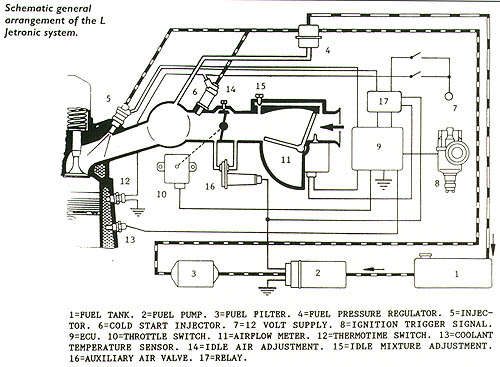|
|
| Fuel injection and the Jaguar XJ6 4.2 Series 3 | [ Main ] [ 1 ] [ 2 ] [ 3 ] [ 4 ] [ 5 ] [ 6 ] |
L JETRONIC ARRIVESL Jetronic first became public knowledge as far back as 1973 simultaneously with the announcement of the mechanical K Jetronic. It seems that Bosch, fearing that some potential customers might be suspicious of electronic control systems, wanted to hedge their bets and pursue both mechanical and electronic routes. How strange that seems now when just about every function on our cars is under electronic control. Along the way even the mechanical K Jetronic spawned the hybrid KE Jetronic - an electronically trimmed mechanical system.Some less endearing features of D Jetronic, the trigger switches and inductive manifold pressure sensor, were dispensed with and, instead of running at constant gauge pressure, fuel pressure was referenced to manifold pressure via a vacuum connection. The pressure drop across the injector nozzle was therefore maintained constant for better operating consistency. A much improved system of connectors, which with only detail alterations has become widely used on most later systems, was also introduced with L Jetronic. Unlike D Jetronic with its complex throttle switch, for L Jetronic the switching functions associated with throttle movement are very simple - the system only senses closed throttle and full load conditions. An important difference from D Jetronic was that no attempt was made to time injector pulses to individual cylinders or groups of cylinders. Instead two pulses per cycle (one per revolution) were provided which experience had shown to give quite acceptable response and drivability without being referenced to any particular part of the cycle. |
The really significant difference however was that L Jetronic, like its
cousin K Jetronic, moved away from indirectly calculating the fuel
requirement of the engine according to manifold pressure and instead
measured the amount of air consumed by the engine and matched the fuel
input to that value (see diagram of general layout). This has a clear
advantage that compensation for individual engine differences due to build
tolerances, wear and so on, is provided automatically, thereby solving a
problem which can afflict manifold pressure sensing systems. Interestingly,
the early 3.6 XJ-S with Lucas Digital injection suffers badly in this
respect, with excessive light load richness as the engine ages, yet the V12
running a similar system hardly seems to suffer at all.
Another first for L Jetronic was the use of Lambda feedback from an exhaust oxygen sensor to achieve accurate stoichiometric fueling in conjunction with a 3 way catalyst. |
| [ Main ] [ 1 ] [ 2 ] [ 3 ] [ 4 ] [ 5 ] [ 6 ] |
Email aj6engineering@ntlworld.com, Tel/Fax:- 0044 (0)1625 573556 |

